1.NIO基本介绍
-
Java NIO(New IO)也有人称之为 java non-blocking IO是从Java 1.4版本开始引入的一个新的IO API,可以替代标准的Java IO API。NIO与原来的IO有同样的作用和目的,但是使用的方式完全不同,NIO支持面向缓冲区 的、基于通道的IO操作。NIO将以更加高效的方式进行文件的读写操作。NIO可以理解为非阻塞IO,传统的IO的read和write只能阻塞执行,线程在读写IO期间不能干其他事情,比如调用socket.read()时,如果服务器一直没有数据传输过来,线程就一直阻塞,而NIO中可以配置socket为非阻塞模式。
-
NIO 相关类都被放在 java.nio 包及子包下,并且对原 java.io 包中的很多类进行改写。
-
NIO 有三大核心部分:Channel( 通道) ,Buffer( 缓冲区), Selector( 选择器)
-
Java NIO 的非阻塞模式,使一个线程从某通道发送请求或者读取数据,但是它仅能得到目前可用的数据,如果目前没有数据可用时,就什么都不会获取,而不是保持线程阻塞,所以直至数据变的可以读取之前,该线程可以继续做其他的事情。 非阻塞写也是如此,一个线程请求写入一些数据到某通道,但不需要等待它完全写入,这个线程同时可以去做别的事情。
-
通俗理解:NIO 是可以做到用一个线程来处理多个操作的。假设有 1000 个请求过来,根据实际情况,可以分配20 或者 80个线程来处理。不像之前的阻塞 IO 那样,非得分配 1000 个。
NIO与BIO对比:
-
BIO 以流的方式处理数据,而 NIO 以块的方式处理数据,块 I/O 的效率比流 I/O 高很多
-
BIO 是阻塞的,NIO 则是非阻塞的
-
BIO 基于字节流和字符流进行操作,而 NIO 基于 Channel(通道)和 Buffer(缓冲区)进行操作,数据总是从通道 读取到缓冲区中,或者从缓冲区写入到通道中。Selector(选择器)用于监听多个通道的事件(比如:连接请求,数据到达等),因此使用单个线程就可以监听多个客户端通道
| NIO | BIO |
|---|---|
| 面向缓冲区(Buffer) | 面向流(Stream) |
| 非阻塞(Non Blocking IO) | 阻塞IO(Blocking IO) |
| 选择器(Selectors) |
2.NIO三大核心组件
NIO 有三大核心部分:Channel( 通道) ,Buffer( 缓冲区), Selector( 选择器)
Buffer缓冲区
缓冲区本质上是一块可以写入数据,然后可以从中读取数据的内存。这块内存被包装成NIO Buffer对象,并提供了一组方法,用来方便的访问该块内存。相比较直接对数组的操作,Buffer API更加容易操作和管理。
Channel(通道)
Java NIO的通道类似流,但又有些不同:既可以从通道中读取数据,又可以写数据到通道。但流的(input或output)读写通常是单向的。 通道可以非阻塞读取和写入通道,通道可以支持读取或写入缓冲区,也支持异步地读写。
Selector选择器
Selector是 一个Java NIO组件,可以能够检查一个或多个 NIO 通道,并确定哪些通道已经准备好进行读取或写入。这样,一个单独的线程可以管理多个channel,从而管理多个网络连接,提高效率
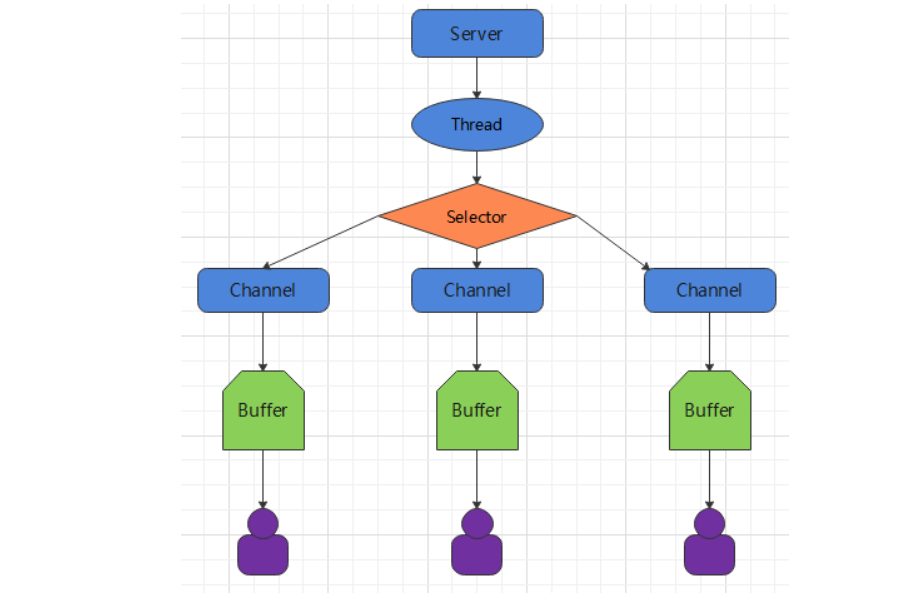
-
每个 channel 都会对应一个 Buffer
-
一个线程对应Selector , 一个Selector对应多个 channel(连接)
-
程序切换到哪个 channel 是由事件决定的
-
Selector 会根据不同的事件,在各个通道上切换
-
Buffer 就是一个内存块 , 底层是一个数组
-
数据的读取写入是通过 Buffer完成的 , BIO 中要么是输入流,或者是输出流, 不能双向,但是 NIO 的 Buffer 是可以读也可以写。
-
Java NIO系统的核心在于:通道(Channel)和缓冲区 (Buffer)。通道表示打开到 IO 设备(例如:文件、 套接字)的连接。若需要使用 NIO 系统,需要获取用于连接 IO 设备的通道以及用于容纳数据的缓冲 区。然后操作缓冲区,对数据进行处理。简而言之,Channel 负责传输, Buffer 负责存取数据
2.1 缓冲区Buffer
2.1.1 基本概念
一个用于特定基本数据类型的容器。由 java.nio 包定义的,所有缓冲区都是 Buffer 抽象类的子类.。Java NIO 中的 Buffer 主要用于与 NIO 通道进行交互,数据是从通道读入缓冲区,从缓冲区写入通道中的
Buffer 就像一个数组,可以保存多个相同类型的数据。根据数据类型不同 ,有以下 Buffer 常用子类:
-
ByteBuffer
-
CharBuffer
-
ShortBuffer
-
IntBuffer
-
LongBuffer
-
FloatBuffer
-
DoubleBuffer
上述 Buffer 类他们都采用相似的方法进行管理数据,只是各自管理的数据类型不同而已。都是通过如下方法获取一个 Buffer 对象:
static XxxBuffer allocate(int capacity) : 创建一个容量为capacity 的 XxxBuffer 对象2.1.2 缓冲区基本属性
Buffer 中的重要概念:
-
容量 (capacity) :作为一个内存块,Buffer具有一定的固定大小,也称为"容量",缓冲区容量不能为负,并且创建后不能更改。
-
限制 (limit) :表示缓冲区中可以操作数据的大小(limit 后数据不能进行读写)。缓冲区的限制不能为负,并且不能大于其容量。 写入模式,限制等于buffer的容量。读取模式下,limit等于写入的数据量。
-
位置 (position):下一个要读取或写入的数据的索引。缓冲区的位置不能为负,并且不能大于其限制
-
标记 (mark)与重置 (reset) :标记是一个索引,通过 Buffer 中的 mark() 方法 指定 Buffer 中一个特定的 position,之后可以通过调用 reset() 方法恢复到这 个 position. 标记、位置、限制、容量遵守以下不变式: 0 <= mark <= position <= limit <= capacity
-
图示:
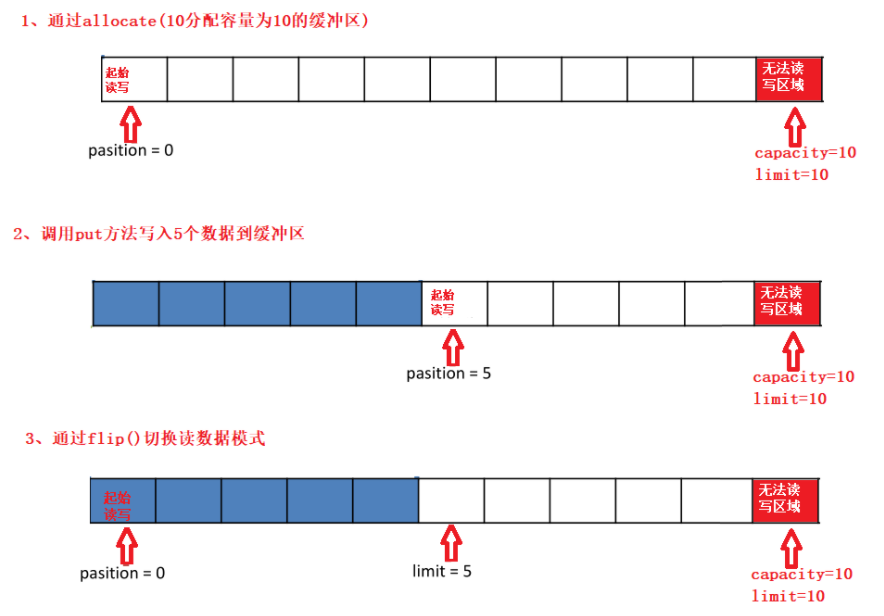
2.1.3 Buffer常见方法
Buffer clear() 清空缓冲区并返回对缓冲区的引用
Buffer flip() 为 将缓冲区的界限设置为当前位置,并将当前位置充值为 0
int capacity() 返回 Buffer 的 capacity 大小
boolean hasRemaining() 判断缓冲区中是否还有元素
int limit() 返回 Buffer 的界限(limit) 的位置
Buffer limit(int n) 将设置缓冲区界限为 n, 并返回一个具有新 limit 的缓冲区对象
Buffer mark() 对缓冲区设置标记
int position() 返回缓冲区的当前位置 position
Buffer position(int n) 将设置缓冲区的当前位置为 n , 并返回修改后的 Buffer 对象
int remaining() 返回 position 和 limit 之间的元素个数
Buffer reset() 将位置 position 转到以前设置的 mark 所在的位置
Buffer rewind() 将位置设为为 0, 取消设置的 mark2.1.4 Buffer的数据操作
Buffer 所有子类提供了两个用于数据操作的方法:get() put() 方法
获取 Buffer中的数据
get() :读取单个字节
get(byte[] dst):批量读取多个字节到 dst 中
get(int index):读取指定索引位置的字节(不会移动 position)
放入数据到 Buffer 中
put(byte b):将给定单个字节写入缓冲区的当前位置
put(byte[] src):将 src 中的字节写入缓冲区的当前位置
put(int index, byte b):将指定字节写入缓冲区的索引位置(不会移动 position)使用Buffer读写数据一般遵循以下四个步骤:
-
1.写入数据到Buffer
-
2.调用flip()方法,转换为读取模式
-
3.从Buffer中读取数据
-
4.调用buffer.clear()方法或者buffer.compact()方法清除缓冲区
2.1.5 代码演示
public class TestBuffer {
@Test
public void test3(){
//分配直接缓冲区
ByteBuffer buf = ByteBuffer.allocateDirect(1024);
System.out.println(buf.isDirect());
}
@Test
public void test2(){
String str = "itheima";
ByteBuffer buf = ByteBuffer.allocate(1024);
buf.put(str.getBytes());
buf.flip();
byte[] dst = new byte[buf.limit()];
buf.get(dst, 0, 2);
System.out.println(new String(dst, 0, 2));
System.out.println(buf.position());
//mark() : 标记
buf.mark();
buf.get(dst, 2, 2);
System.out.println(new String(dst, 2, 2));
System.out.println(buf.position());
//reset() : 恢复到 mark 的位置
buf.reset();
System.out.println(buf.position());
//判断缓冲区中是否还有剩余数据
if(buf.hasRemaining()){
//获取缓冲区中可以操作的数量
System.out.println(buf.remaining());
}
}
@Test
public void test1(){
String str = "itheima";
//1. 分配一个指定大小的缓冲区
ByteBuffer buf = ByteBuffer.allocate(1024);
System.out.println("-----------------allocate()----------------");
System.out.println(buf.position());
System.out.println(buf.limit());
System.out.println(buf.capacity());
//2. 利用 put() 存入数据到缓冲区中
buf.put(str.getBytes());
System.out.println("-----------------put()----------------");
System.out.println(buf.position());
System.out.println(buf.limit());
System.out.println(buf.capacity());
//3. 切换读取数据模式
buf.flip();
System.out.println("-----------------flip()----------------");
System.out.println(buf.position());
System.out.println(buf.limit());
System.out.println(buf.capacity());
//4. 利用 get() 读取缓冲区中的数据
byte[] dst = new byte[buf.limit()];
buf.get(dst);
System.out.println(new String(dst, 0, dst.length));
System.out.println("-----------------get()----------------");
System.out.println(buf.position());
System.out.println(buf.limit());
System.out.println(buf.capacity());
//5. rewind() : 可重复读
buf.rewind();
System.out.println("-----------------rewind()----------------");
System.out.println(buf.position());
System.out.println(buf.limit());
System.out.println(buf.capacity());
//6. clear() : 清空缓冲区. 但是缓冲区中的数据依然存在,但是处于"被遗忘"状态
buf.clear();
System.out.println("-----------------clear()----------------");
System.out.println(buf.position());
System.out.println(buf.limit());
System.out.println(buf.capacity());
System.out.println((char)buf.get());
}
}2.1.6 直接与非直接缓冲区
什么是直接内存与非直接内存
根据官方文档的描述:
byte byffer可以是两种类型,一种是基于直接内存(也就是非堆内存);另一种是非直接内存(也就是堆内存)。对于直接内存来说,JVM将会在IO操作上具有更高的性能,因为它直接作用于本地系统的IO操作。而非直接内存,也就是堆内存中的数据,如果要作IO操作,会先从本进程内存复制到直接内存,再利用本地IO处理。
从数据流的角度,非直接内存是下面这样的作用链:
本地IO-->直接内存-->非直接内存-->直接内存-->本地IO而直接内存是:
本地IO-->直接内存-->本地IO很明显,在做IO处理时,比如网络发送大量数据时,直接内存会具有更高的效率。直接内存使用allocateDirect创建,但是它比申请普通的堆内存需要耗费更高的性能。不过,这部分的数据是在JVM之外的,因此它不会占用应用的内存。所以呢,当你有很大的数据要缓存,并且它的生命周期又很长,那么就比较适合使用直接内存。只是一般来说,如果不是能带来很明显的性能提升,还是推荐直接使用堆内存。字节缓冲区是直接缓冲区还是非直接缓冲区可通过调用其 isDirect() 方法来确定。
使用场景
-
1 有很大的数据需要存储,它的生命周期又很长
-
2 适合频繁的IO操作,比如网络并发场景
2.2 通道Channel
2.2.1 基本概念
通道(Channel):由 java.nio.channels 包定义 的。Channel 表示 IO 源与目标打开的连接。 Channel 类似于传统的"流"。只不过 Channel 本身不能直接访问数据,Channel 只能与 Buffer 进行交互。
1、 NIO 的通道类似于流,但有些区别如下:
-
通道可以同时进行读写,而流只能读或者只能写
-
通道可以实现异步读写数据
-
通道可以从缓冲读数据,也可以写数据到缓冲:
2、BIO 中的 stream 是单向的,例如 FileInputStream 对象只能进行读取数据的操作,而 NIO 中的通道(Channel) 是双向的,可以读操作,也可以写操作。
3、Channel 在 NIO 中是一个接口
public interface Channel extends Closeable{}常用的Channel实现类:
-
FileChannel:用于读取、写入、映射和操作文件的通道。
-
DatagramChannel:通过 UDP 读写网络中的数据通道。
-
SocketChannel:通过 TCP 读写网络中的数据。
-
ServerSocketChannel:可以监听新进来的 TCP 连接,对每一个新进来的连接都会创建一个 SocketChannel。 【ServerSocketChanne 类似 ServerSocket , SocketChannel 类似 Socket】
2.2.2 FileChannel类
获取通道的一种方式是对支持通道的对象调用getChannel() 方法。支持通道的类如下:
-
FileInputStream
-
FileOutputStream
-
RandomAccessFile
-
DatagramSocket
-
Socket
-
ServerSocket 获取通道的其他方式是使用 Files 类的静态方法 newByteChannel() 获取字节通道。或者通过通道的静态方法 open() 打开并返回指定通道
FileChannel常用方法:
int read(ByteBuffer dst) 从Channel 到 中读取数据到 ByteBuffer
long read(ByteBuffer[] dsts) 将Channel 到 中的数据"分散"到 ByteBuffer[]
int write(ByteBuffer src) 将ByteBuffer 到 中的数据写入到 Channel
long write(ByteBuffer[] srcs) 将ByteBuffer[] 到 中的数据"聚集"到 Channel
long position() 返回此通道的文件位置
FileChannel position(long p) 设置此通道的文件位置
long size() 返回此通道的文件的当前大小
FileChannel truncate(long s) 将此通道的文件截取为给定大小
void force(boolean metaData) 强制将所有对此通道的文件更新写入到存储设备中2.2.3 案例-本地文件写数据
需求:使用前面学习后的 ByteBuffer(缓冲) 和 FileChannel(通道), 将 "hello,黑马Java程序员!" 写入到 data.txt 中.
import org.junit.Test;
import java.io.FileNotFoundException;
import java.io.FileOutputStream;
import java.io.OutputStream;
import java.nio.ByteBuffer;
import java.nio.channels.FileChannel;
public class ChannelTest {
@Test
public void write(){
try {
// 1、字节输出流通向目标文件
FileOutputStream fos = new FileOutputStream("data01.txt");
// 2、得到字节输出流对应的通道Channel
FileChannel channel = fos.getChannel();
// 3、分配缓冲区
ByteBuffer buffer = ByteBuffer.allocate(1024);
buffer.put("hello,黑马Java程序员!".getBytes());
// 4、把缓冲区切换成写出模式
buffer.flip();
channel.write(buffer);
channel.close();
System.out.println("写数据到文件中!");
} catch (Exception e) {
e.printStackTrace();
}
}
}2.2.4 案例-本地文件读数据
需求:使用前面学习后的 ByteBuffer(缓冲) 和 FileChannel(通道), 将 data01.txt 中的数据读入到程序,并显示在控制台屏幕。
public class ChannelTest {
@Test
public void read() throws Exception {
// 1、定义一个文件字节输入流与源文件接通
FileInputStream is = new FileInputStream("data01.txt");
// 2、需要得到文件字节输入流的文件通道
FileChannel channel = is.getChannel();
// 3、定义一个缓冲区
ByteBuffer buffer = ByteBuffer.allocate(1024);
// 4、读取数据到缓冲区
channel.read(buffer);
buffer.flip();
// 5、读取出缓冲区中的数据并输出即可
String rs = new String(buffer.array(),0,buffer.remaining());
System.out.println(rs);
}2.2.5 案例-使用Buffer完成文本复制
使用 FileChannel(通道) ,完成文件的拷贝。
@Test
public void copy() throws Exception {
// 源文件
File srcFile = new File("C:\\Users\\dlei\\Desktop\\BIO,NIO,AIO\\文件\\壁纸.jpg");
File destFile = new File("C:\\Users\\dlei\\Desktop\\BIO,NIO,AIO\\文件\\壁纸new.jpg");
// 得到一个字节字节输入流
FileInputStream fis = new FileInputStream(srcFile);
// 得到一个字节输出流
FileOutputStream fos = new FileOutputStream(destFile);
// 得到的是文件通道
FileChannel isChannel = fis.getChannel();
FileChannel osChannel = fos.getChannel();
// 分配缓冲区
ByteBuffer buffer = ByteBuffer.allocate(1024);
while(true){
// 必须先清空缓冲然后再写入数据到缓冲区
buffer.clear();
// 开始读取一次数据
int flag = isChannel.read(buffer);
if(flag == -1){
break;
}
// 已经读取了数据 ,把缓冲区的模式切换成可读模式
buffer.flip();
// 把数据写出到
osChannel.write(buffer);
}
isChannel.close();
osChannel.close();
System.out.println("复制完成!");
}2.2.6 案例-分散 (Scatter) 和聚集 (Gather)
分散读取(Scatter ):是指把Channel通道的数据读入到多个缓冲区中去
聚集写入(Gathering )是指将多个 Buffer 中的数据"聚集"到 Channel
//分散和聚集
@Test
public void test() throws IOException{
RandomAccessFile raf1 = new RandomAccessFile("1.txt", "rw");
//1. 获取通道
FileChannel channel1 = raf1.getChannel();
//2. 分配指定大小的缓冲区
ByteBuffer buf1 = ByteBuffer.allocate(100);
ByteBuffer buf2 = ByteBuffer.allocate(1024);
//3. 分散读取
ByteBuffer[] bufs = {buf1, buf2};
channel1.read(bufs);
for (ByteBuffer byteBuffer : bufs) {
byteBuffer.flip();
}
System.out.println(new String(bufs[0].array(), 0, bufs[0].limit()));
System.out.println("-----------------");
System.out.println(new String(bufs[1].array(), 0, bufs[1].limit()));
//4. 聚集写入
RandomAccessFile raf2 = new RandomAccessFile("2.txt", "rw");
FileChannel channel2 = raf2.getChannel();
channel2.write(bufs);
}2.2.7 案例-transferFrom()
从目标通道中去复制原通道数据
@Test
public void test02() throws Exception {
// 1、字节输入管道
FileInputStream is = new FileInputStream("data01.txt");
FileChannel isChannel = is.getChannel();
// 2、字节输出流管道
FileOutputStream fos = new FileOutputStream("data03.txt");
FileChannel osChannel = fos.getChannel();
// 3、复制
osChannel.transferFrom(isChannel,isChannel.position(),isChannel.size());
isChannel.close();
osChannel.close();
}2.2.8 案例-transferTo()
把原通道数据复制到目标通道
@Test
public void test02() throws Exception {
// 1、字节输入管道
FileInputStream is = new FileInputStream("data01.txt");
FileChannel isChannel = is.getChannel();
// 2、字节输出流管道
FileOutputStream fos = new FileOutputStream("data04.txt");
FileChannel osChannel = fos.getChannel();
// 3、复制
isChannel.transferTo(isChannel.position() , isChannel.size() , osChannel);
isChannel.close();
osChannel.close();
}2.3 选择器Selector
2.3.1 概述
选择器(Selector) 是 SelectableChannel 对象的多路复用器,Selector 可以同时监控多个 SelectableChannel 的 IO 状况,也就是说,利用 Selector可使一个单独的线程管理多个 Channel。Selector 是非阻塞 IO 的核心
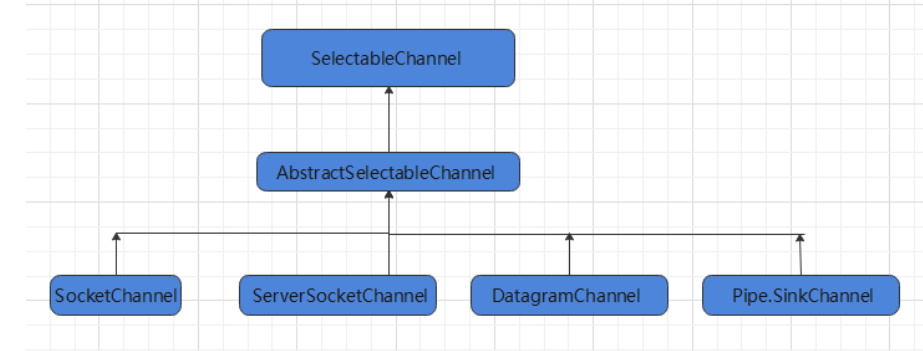
-
Java 的 NIO,用非阻塞的 IO 方式。可以用一个线程,处理多个的客户端连接,就会使用到 Selector(选择器)
-
Selector 能够检测多个注册的通道上是否有事件发生(注意:多个 Channel 以事件的方式可以注册到同一个 Selector),如果有事件发生,便获取事件然后针对每个事件进行相应的处理。这样就可以只用一个单线程去管理多个通道,也就是管理多个连接和请求。
-
只有在连接/通道真正有读写事件发生时,才会进行读写,就大大地减少了系统开销,并且不必为每个连接都创建一个线程,不用去维护多个线程
-
避免了多线程之间的上下文切换导致的开销
2.3.2 应用
创建 Selector :通过调用 Selector.open() 方法创建一个 Selector。
Selector selector = Selector.open();向选择器注册通道:SelectableChannel.register(Selector sel, int ops)
//1. 获取通道
ServerSocketChannel ssChannel = ServerSocketChannel.open();
//2. 切换非阻塞模式
ssChannel.configureBlocking(false);
//3. 绑定连接
ssChannel.bind(new InetSocketAddress(9898));
//4. 获取选择器
Selector selector = Selector.open();
//5. 将通道注册到选择器上, 并且指定"监听接收事件"
ssChannel.register(selector, SelectionKey.OP_ACCEPT);当调用 register(Selector sel, int ops) 将通道注册选择器时,选择器对通道的监听事件,需要通过第二个参数 ops 指定。可以监听的事件类型(用 可使用 SelectionKey 的四个常量 表示):
-
读 : SelectionKey.OP_READ (1)
-
写 : SelectionKey.OP_WRITE (4)
-
连接 : SelectionKey.OP_CONNECT (8)
-
接收 : SelectionKey.OP_ACCEPT (16)
-
若注册时不止监听一个事件,则可以使用"位或"操作符连接。
int interestSet = SelectionKey.OP_READ|SelectionKey.OP_WRITE
2.4 NIO非阻塞式网络通信原理分析
Selector可以实现: 一个 I/O 线程可以并发处理 N 个客户端连接和读写操作,这从根本上解决了传统同步阻塞 I/O 一连接一线程模型,架构的性能、弹性伸缩能力和可靠性都得到了极大的提升。
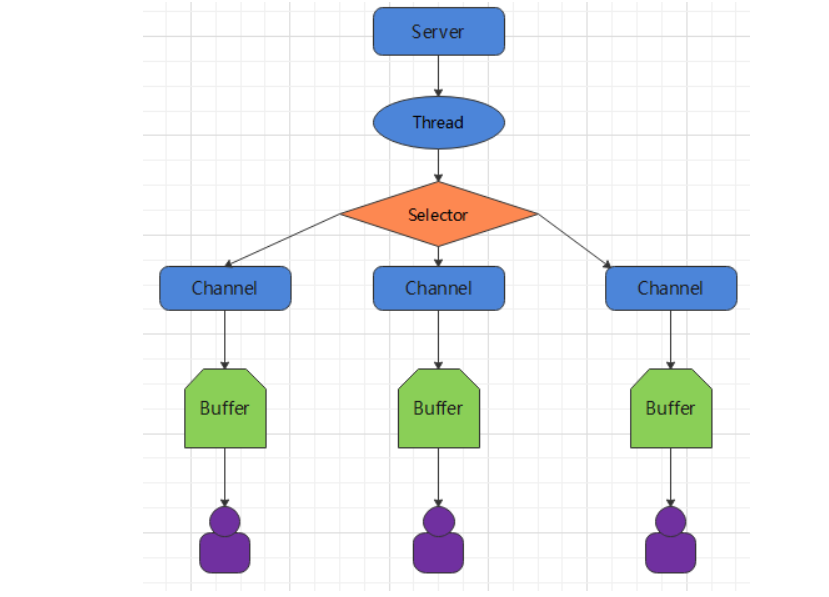
2.4.1 服务端流程
1、当客户端连接服务端时,服务端会通过 ServerSocketChannel 得到 SocketChannel:
ServerSocketChannel ssChannel = ServerSocketChannel.open();2、切换非阻塞模式
ssChannel.configureBlocking(false);3、绑定连接
ssChannel.bind(new InetSocketAddress(9999));4、 获取选择器
Selector selector = Selector.open();5、 将通道注册到选择器上, 并且指定"监听接收事件"
ssChannel.register(selector, SelectionKey.OP_ACCEPT);6、 轮询式的获取选择器
//轮询式的获取选择器上已经"准备就绪"的事件
while (selector.select() > 0) {
System.out.println("轮一轮");
//7. 获取当前选择器中所有注册的"选择键(已就绪的监听事件)"
Iterator<SelectionKey> it = selector.selectedKeys().iterator();
while (it.hasNext()) {
//8. 获取准备"就绪"的是事件
SelectionKey sk = it.next();
//9. 判断具体是什么事件准备就绪
if (sk.isAcceptable()) {
//10. 若"接收就绪",获取客户端连接
SocketChannel sChannel = ssChannel.accept();
//11. 切换非阻塞模式
sChannel.configureBlocking(false);
//12. 将该通道注册到选择器上
sChannel.register(selector, SelectionKey.OP_READ);
} else if (sk.isReadable()) {
//13. 获取当前选择器上"读就绪"状态的通道
SocketChannel sChannel = (SocketChannel) sk.channel();
//14. 读取数据
ByteBuffer buf = ByteBuffer.allocate(1024);
int len = 0;
while ((len = sChannel.read(buf)) > 0) {
buf.flip();
System.out.println(new String(buf.array(), 0, len));
buf.clear();
}
}
//15. 取消选择键 SelectionKey
it.remove();
}
}
}2.4.2 客户端流程
获取通道:
SocketChannel sChannel = SocketChannel.open(new InetSocketAddress("127.0.0.1", 9999));切换非阻塞模式:
sChannel.configureBlocking(false);分配指定大小的缓冲区:
ByteBuffer buf = ByteBuffer.allocate(1024);发送数据给服务端:
Scanner scan = new Scanner(System.in);
while(scan.hasNext()){
String str = scan.nextLine();
buf.put((new SimpleDateFormat("yyyy/MM/dd HH:mm:ss").format(System.currentTimeMillis())
+ "\n" + str).getBytes());
buf.flip();
sChannel.write(buf);
buf.clear();
}
//关闭通道
sChannel.close();3. NIO编程案例
3.1 入门案例
需求:服务端接收客户端的连接请求,并接收多个客户端发送过来的事件。
/**
客户端
*/
public class Client {
public static void main(String[] args) throws Exception {
//1. 获取通道
SocketChannel sChannel = SocketChannel.open(new InetSocketAddress("127.0.0.1", 9999));
//2. 切换非阻塞模式
sChannel.configureBlocking(false);
//3. 分配指定大小的缓冲区
ByteBuffer buf = ByteBuffer.allocate(1024);
//4. 发送数据给服务端
Scanner scan = new Scanner(System.in);
while(scan.hasNext()){
String str = scan.nextLine();
buf.put((new SimpleDateFormat("yyyy/MM/dd HH:mm:ss").format(System.currentTimeMillis())
+ "\n" + str).getBytes());
buf.flip();
sChannel.write(buf);
buf.clear();
}
//5. 关闭通道
sChannel.close();
}
}
/**
服务端
*/
public class Server {
public static void main(String[] args) throws IOException {
//1. 获取通道
ServerSocketChannel ssChannel = ServerSocketChannel.open();
//2. 切换非阻塞模式
ssChannel.configureBlocking(false);
//3. 绑定连接
ssChannel.bind(new InetSocketAddress(9999));
//4. 获取选择器
Selector selector = Selector.open();
//5. 将通道注册到选择器上, 并且指定"监听接收事件"
ssChannel.register(selector, SelectionKey.OP_ACCEPT);
//6. 轮询式的获取选择器上已经"准备就绪"的事件
while (selector.select() > 0) {
System.out.println("轮一轮");
//7. 获取当前选择器中所有注册的"选择键(已就绪的监听事件)"
Iterator<SelectionKey> it = selector.selectedKeys().iterator();
while (it.hasNext()) {
//8. 获取准备"就绪"的是事件
SelectionKey sk = it.next();
//9. 判断具体是什么事件准备就绪
if (sk.isAcceptable()) {
//10. 若"接收就绪",获取客户端连接
SocketChannel sChannel = ssChannel.accept();
//11. 切换非阻塞模式
sChannel.configureBlocking(false);
//12. 将该通道注册到选择器上
sChannel.register(selector, SelectionKey.OP_READ);
} else if (sk.isReadable()) {
//13. 获取当前选择器上"读就绪"状态的通道
SocketChannel sChannel = (SocketChannel) sk.channel();
//14. 读取数据
ByteBuffer buf = ByteBuffer.allocate(1024);
int len = 0;
while ((len = sChannel.read(buf)) > 0) {
buf.flip();
System.out.println(new String(buf.array(), 0, len));
buf.clear();
}
}
//15. 取消选择键 SelectionKey
it.remove();
}
}
}
}3.2 基于NIO实现IM群聊系统
目标:
需求:进一步理解 NIO 非阻塞网络编程机制,实现多人群聊
-
编写一个 NIO 群聊系统,实现客户端与客户端的通信需求(非阻塞)
-
服务器端:可以监测用户上线,离线,并实现消息转发功能
-
客户端:通过 channel 可以无阻塞发送消息给其它所有客户端用户,同时可以接受其它客户端用户通过服务端转发来的消息
服务端实现:
public class Server {
//定义属性
private Selector selector;
private ServerSocketChannel ssChannel;
private static final int PORT = 9999;
//构造器
//初始化工作
public Server() {
try {
// 1、获取通道
ssChannel = ServerSocketChannel.open();
// 2、切换为非阻塞模式
ssChannel.configureBlocking(false);
// 3、绑定连接的端口
ssChannel.bind(new InetSocketAddress(PORT));
// 4、获取选择器Selector
selector = Selector.open();
// 5、将通道都注册到选择器上去,并且开始指定监听接收事件
ssChannel.register(selector , SelectionKey.OP_ACCEPT);
}catch (IOException e) {
e.printStackTrace();
}
}
//监听
public void listen() {
System.out.println("监听线程: " + Thread.currentThread().getName());
try {
while (selector.select() > 0){
System.out.println("开始一轮事件处理~~~");
// 7、获取选择器中的所有注册的通道中已经就绪好的事件
Iterator<SelectionKey> it = selector.selectedKeys().iterator();
// 8、开始遍历这些准备好的事件
while (it.hasNext()){
// 提取当前这个事件
SelectionKey sk = it.next();
// 9、判断这个事件具体是什么
if(sk.isAcceptable()){
// 10、直接获取当前接入的客户端通道
SocketChannel schannel = ssChannel.accept();
// 11 、切换成非阻塞模式
schannel.configureBlocking(false);
// 12、将本客户端通道注册到选择器
System.out.println(schannel.getRemoteAddress() + " 上线 ");
schannel.register(selector , SelectionKey.OP_READ);
//提示
}else if(sk.isReadable()){
//处理读 (专门写方法..)
readData(sk);
}
it.remove(); // 处理完毕之后需要移除当前事件
}
}
}catch (Exception e) {
e.printStackTrace();
}finally {
//发生异常处理....
}
}
//读取客户端消息
private void readData(SelectionKey key) {
//取到关联的channle
SocketChannel channel = null;
try {
//得到channel
channel = (SocketChannel) key.channel();
//创建buffer
ByteBuffer buffer = ByteBuffer.allocate(1024);
int count = channel.read(buffer);
//根据count的值做处理
if(count > 0) {
//把缓存区的数据转成字符串
String msg = new String(buffer.array());
//输出该消息
System.out.println("form 客户端: " + msg);
//向其它的客户端转发消息(去掉自己), 专门写一个方法来处理
sendInfoToOtherClients(msg, channel);
}
}catch (IOException e) {
try {
System.out.println(channel.getRemoteAddress() + " 离线了..");
e.printStackTrace();
//取消注册
key.cancel();
//关闭通道
channel.close();
}catch (IOException e2) {
e2.printStackTrace();;
}
}
}
//转发消息给其它客户(通道)
private void sendInfoToOtherClients(String msg, SocketChannel self ) throws IOException{
System.out.println("服务器转发消息中...");
System.out.println("服务器转发数据给客户端线程: " + Thread.currentThread().getName());
//遍历 所有注册到selector 上的 SocketChannel,并排除 self
for(SelectionKey key: selector.keys()) {
//通过 key 取出对应的 SocketChannel
Channel targetChannel = key.channel();
//排除自己
if(targetChannel instanceof SocketChannel && targetChannel != self) {
//转型
SocketChannel dest = (SocketChannel)targetChannel;
//将msg 存储到buffer
ByteBuffer buffer = ByteBuffer.wrap(msg.getBytes());
//将buffer 的数据写入 通道
dest.write(buffer);
}
}
}
public static void main(String[] args) {
//创建服务器对象
Server groupChatServer = new Server();
groupChatServer.listen();
}
}客户端实现:
import java.io.IOException;
import java.net.InetSocketAddress;
import java.nio.ByteBuffer;
import java.nio.channels.SelectionKey;
import java.nio.channels.Selector;
import java.nio.channels.SocketChannel;
import java.util.Iterator;
import java.util.Scanner;
public class Client {
//定义相关的属性
private final String HOST = "127.0.0.1"; // 服务器的ip
private final int PORT = 9999; //服务器端口
private Selector selector;
private SocketChannel socketChannel;
private String username;
//构造器, 完成初始化工作
public Client() throws IOException {
selector = Selector.open();
//连接服务器
socketChannel = socketChannel.open(new InetSocketAddress("127.0.0.1", PORT));
//设置非阻塞
socketChannel.configureBlocking(false);
//将channel 注册到selector
socketChannel.register(selector, SelectionKey.OP_READ);
//得到username
username = socketChannel.getLocalAddress().toString().substring(1);
System.out.println(username + " is ok...");
}
//向服务器发送消息
public void sendInfo(String info) {
info = username + " 说:" + info;
try {
socketChannel.write(ByteBuffer.wrap(info.getBytes()));
}catch (IOException e) {
e.printStackTrace();
}
}
//读取从服务器端回复的消息
public void readInfo() {
try {
int readChannels = selector.select();
if(readChannels > 0) {//有可以用的通道
Iterator<SelectionKey> iterator = selector.selectedKeys().iterator();
while (iterator.hasNext()) {
SelectionKey key = iterator.next();
if(key.isReadable()) {
//得到相关的通道
SocketChannel sc = (SocketChannel) key.channel();
//得到一个Buffer
ByteBuffer buffer = ByteBuffer.allocate(1024);
//读取
sc.read(buffer);
//把读到的缓冲区的数据转成字符串
String msg = new String(buffer.array());
System.out.println(msg.trim());
}
}
iterator.remove(); //删除当前的selectionKey, 防止重复操作
} else {
//System.out.println("没有可以用的通道...");
}
}catch (Exception e) {
e.printStackTrace();
}
}
public static void main(String[] args) throws Exception {
//启动我们客户端
Client chatClient = new Client();
//启动一个线程, 每个3秒,读取从服务器发送数据
new Thread() {
public void run() {
while (true) {
chatClient.readInfo();
try {
Thread.currentThread().sleep(3000);
}catch (InterruptedException e) {
e.printStackTrace();
}
}
}
}.start();
//发送数据给服务器端
Scanner scanner = new Scanner(System.in);
while (scanner.hasNextLine()) {
String s = scanner.nextLine();
chatClient.sendInfo(s);
}
}
}4. BIO VS NIO
4.1 Stream vs channel
-
stream 不会自动缓冲数据,channel 会利用系统提供的发送缓冲区、接收缓冲区(更为底层)
-
stream 仅支持阻塞 API,channel 同时支持阻塞、非阻塞 API,网络 channel 可配合 selector 实现多路复用
-
二者均为全双工,即读写可以同时进行
4.2 IO模型
同步阻塞、同步非阻塞、同步多路复用、异步阻塞(没有此情况)、异步非阻塞
-
同步:线程自己去获取结果(一个线程)
-
异步:线程自己不去获取结果,而是由其它线程送结果(至少两个线程)
当调用一次 channel.read 或 stream.read 后,会切换至操作系统内核态来完成真正数据读取,而读取又分为两个阶段,分别为:
-
等待数据阶段
-
复制数据阶段
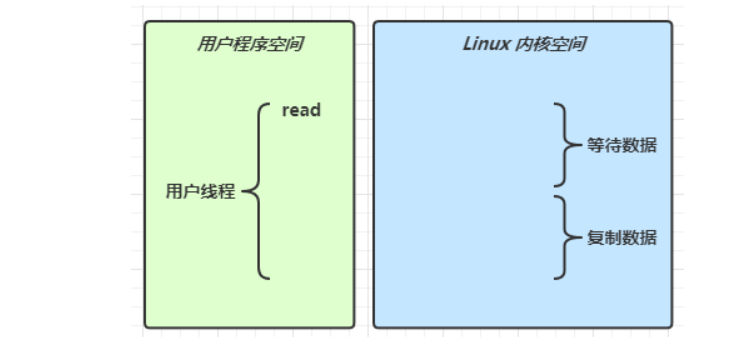
阻塞 IO:
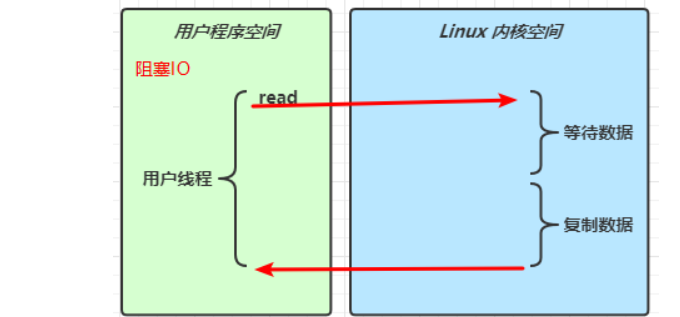
非阻塞 IO: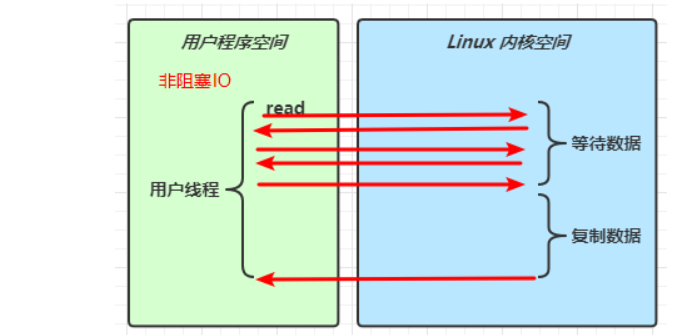
多路复用:
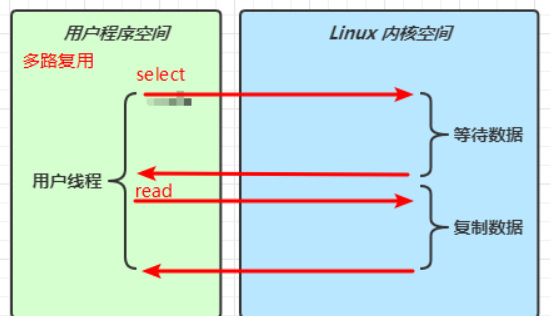
信号驱动
异步 IO:
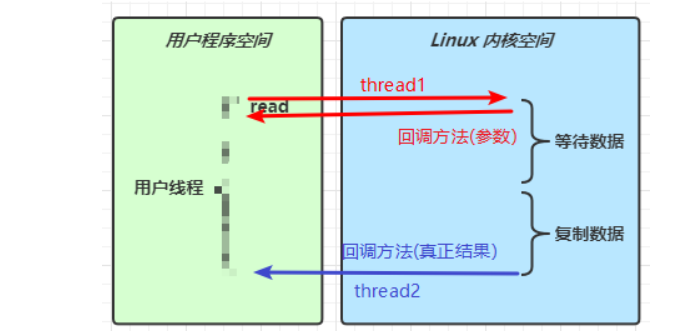
阻塞 IO vs 多路复用:
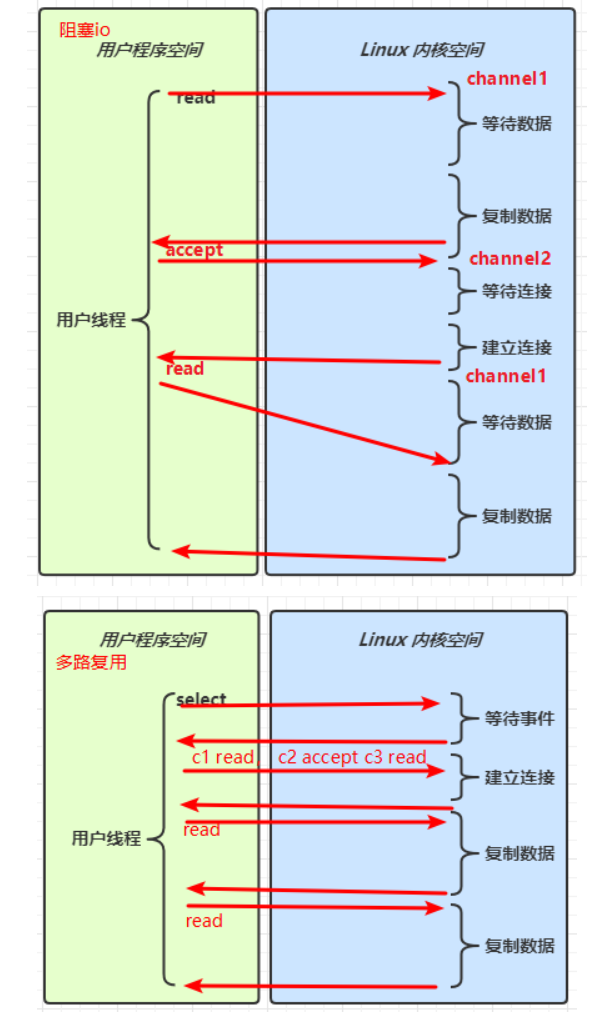
4.3 零拷贝
传统 IO 问题:
传统的 IO 将一个文件通过 socket 写出
File f = new File("helloword/data.txt");
RandomAccessFile file = new RandomAccessFile(file, "r");
byte[] buf = new byte[(int)f.length()];
file.read(buf);
Socket socket = ...;
socket.getOutputStream().write(buf);内部工作流程是这样的:
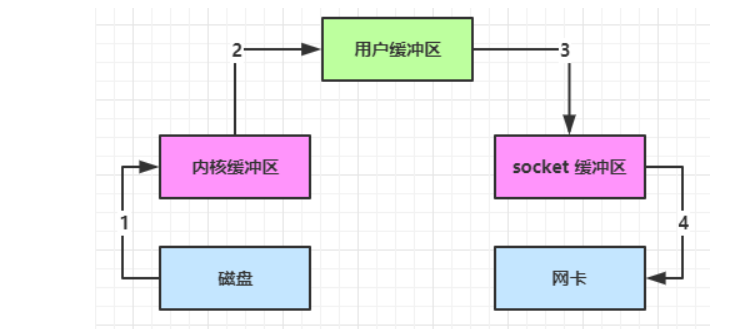
-
java 本身并不具备 IO 读写能力,因此 read 方法调用后,要从 java 程序的用户态 切换至内核态 ,去调用操作系统(Kernel)的读能力,将数据读入内核缓冲区。这期间用户线程阻塞,操作系统使用 DMA(Direct Memory Access)来实现文件读,其间也不会使用 cpu。DMA 也可以理解为硬件单元,用来解放 cpu 完成文件 IO
-
从内核态 切换回用户态 ,将数据从内核缓冲区 读入用户缓冲区(即 byte[] buf),这期间 cpu 会参与拷贝,无法利用 DMA
-
调用 write 方法,这时将数据从用户缓冲区 (byte[] buf)写入 socket 缓冲区,cpu 会参与拷贝
-
接下来要向网卡写数据,这项能力 java 又不具备,因此又得从用户态 切换至内核态 ,调用操作系统的写能力,使用 DMA 将 socket 缓冲区的数据写入网卡,不会使用 cpu
可以看到中间环节较多,java 的 IO 实际不是物理设备级别的读写,而是缓存的复制,底层的真正读写是操作系统来完成的
-
用户态与内核态的切换发生了 3 次,这个操作比较重量级
-
数据拷贝了共 4 次
NIO 优化:
通过 DirectByteBuf
-
ByteBuffer.allocate(10) HeapByteBuffer 使用的还是 java 内存
-
ByteBuffer.allocateDirect(10) DirectByteBuffer 使用的是操作系统内存
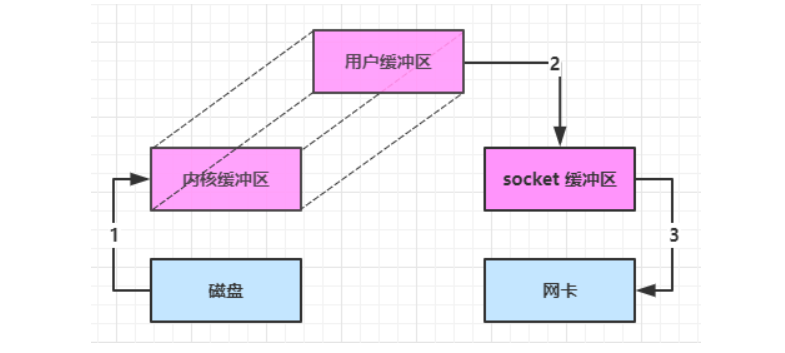
大部分步骤与优化前相同,不再赘述。唯有一点:java 可以使用 DirectByteBuf 将堆外内存映射到 jvm 内存中来直接访问使用
-
这块内存不受 jvm 垃圾回收的影响,因此内存地址固定,有助于 IO 读写
-
java 中的 DirectByteBuf 对象仅维护了此内存的虚引用,内存回收分成两步
-
DirectByteBuf 对象被垃圾回收,将虚引用加入引用队列
-
通过专门线程访问引用队列,根据虚引用释放堆外内存
-
-
减少了一次数据拷贝,用户态与内核态的切换次数没有减少
进一步优化(底层采用了 linux 2.1 后提供的 sendFile 方法),java 中对应着两个 channel 调用 transferTo/transferFrom 方法拷贝数据

-
java 调用 transferTo 方法后,要从 java 程序的用户态 切换至内核态 ,使用 DMA将数据读入内核缓冲区,不会使用 cpu
-
数据从内核缓冲区 传输到 socket 缓冲区,cpu 会参与拷贝
-
最后使用 DMA 将 socket 缓冲区的数据写入网卡,不会使用 cpu
可以看到
-
只发生了一次用户态与内核态的切换
-
数据拷贝了 3 次
进一步优化(linux 2.4)
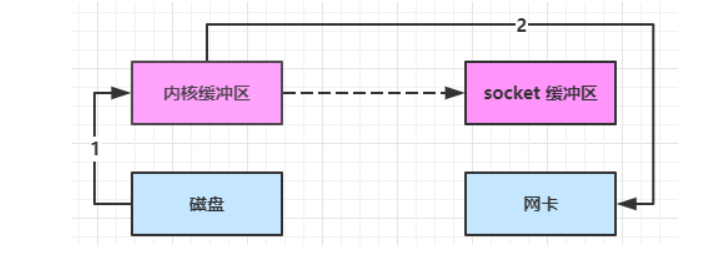
-
java 调用 transferTo 方法后,要从 java 程序的用户态 切换至内核态 ,使用 DMA将数据读入内核缓冲区,不会使用 cpu
-
只会将一些 offset 和 length 信息拷入 socket 缓冲区,几乎无消耗
-
使用 DMA 将 内核缓冲区的数据写入网卡,不会使用 cpu
整个过程仅只发生了一次用户态与内核态的切换,数据拷贝了 2 次。所谓的【零拷贝】,并不是真正无拷贝,而是在不会拷贝重复数据到 jvm 内存中,零拷贝的优点有
-
更少的用户态与内核态的切换
-
不利用 cpu 计算,减少 cpu 缓存伪共享
-
零拷贝适合小文件传输
5.AIO
-
Java AIO(NIO.2) : 异步非阻塞,服务器实现模式为一个有效请求一个线程,客户端的I/O请求都是由OS先完成了再通知服务器应用去启动线程进行处理。
AIO
异步非阻塞,基于NIO的,可以称之为NIO2.0
BIO NIO AIO
Socket SocketChannel AsynchronousSocketChannel
ServerSocket ServerSocketChannel AsynchronousServerSocketChannel
与NIO不同,当进行读写操作时,只须直接调用API的read或write方法即可, 这两种方法均为异步的,对于读操作而言,当有流可读取时,操作系统会将可读的流传入read方法的缓冲区,对于写操作而言,当操作系统将write方法传递的流写入完毕时,操作系统主动通知应用程序
即可以理解为,read/write方法都是异步的,完成后会主动调用回调函数。在JDK1.7中,这部分内容被称作NIO.2,主要在Java.nio.channels包下增加了下面四个异步通道:
AsynchronousSocketChannel
AsynchronousServerSocketChannel
AsynchronousFileChannel
AsynchronousDatagramChannelAIO 用来解决数据复制阶段的阻塞问题
-
同步意味着,在进行读写操作时,线程需要等待结果,还是相当于闲置
-
异步意味着,在进行读写操作时,线程不必等待结果,而是将来由操作系统来通过回调方式由另外的线程来获得结果
异步模型需要底层操作系统(Kernel)提供支持
Windows 系统通过 IOCP 实现了真正的异步 IO
Linux 系统异步 IO 在 2.6 版本引入,但其底层实现还是用多路复用模拟了异步 IO,性能没有优势
文件 AIO
先来看看 AsynchronousFileChannel
@Slf4j
public class AioDemo1 {
public static void main(String[] args) throws IOException {
try{
AsynchronousFileChannel s =
AsynchronousFileChannel.open(
Paths.get("1.txt"), StandardOpenOption.READ);
ByteBuffer buffer = ByteBuffer.allocate(2);
log.debug("begin...");
s.read(buffer, 0, null, new CompletionHandler<Integer, ByteBuffer>() {
@Override
public void completed(Integer result, ByteBuffer attachment) {
log.debug("read completed...{}", result);
buffer.flip();
debug(buffer);
}
@Override
public void failed(Throwable exc, ByteBuffer attachment) {
log.debug("read failed...");
}
});
} catch (IOException e) {
e.printStackTrace();
}
log.debug("do other things...");
System.in.read();
}
}输出:
13:44:56 [DEBUG] [main] c.i.aio.AioDemo1 - begin...
13:44:56 [DEBUG] [main] c.i.aio.AioDemo1 - do other things...
13:44:56 [DEBUG] [Thread-5] c.i.aio.AioDemo1 - read completed...2
+-------------------------------------------------+
| 0 1 2 3 4 5 6 7 8 9 a b c d e f |
+--------+-------------------------------------------------+----------------+
|00000000| 61 0d |a. |
+--------+-------------------------------------------------+----------------+可以看到
-
响应文件读取成功的是另一个线程 Thread-5
-
主线程并没有 IO 操作阻塞
守护线程:
默认文件 AIO 使用的线程都是守护线程,所以最后要执行 System.in.read() 以避免守护线程意外结束
网络 AIO
public class AioServer {
public static void main(String[] args) throws IOException {
AsynchronousServerSocketChannel ssc = AsynchronousServerSocketChannel.open();
ssc.bind(new InetSocketAddress(8080));
ssc.accept(null, new AcceptHandler(ssc));
System.in.read();
}
private static void closeChannel(AsynchronousSocketChannel sc) {
try {
System.out.printf("[%s] %s close\n", Thread.currentThread().getName(), sc.getRemoteAddress());
sc.close();
} catch (IOException e) {
e.printStackTrace();
}
}
private static class ReadHandler implements CompletionHandler<Integer, ByteBuffer> {
private final AsynchronousSocketChannel sc;
public ReadHandler(AsynchronousSocketChannel sc) {
this.sc = sc;
}
@Override
public void completed(Integer result, ByteBuffer attachment) {
try {
if (result == -1) {
closeChannel(sc);
return;
}
System.out.printf("[%s] %s read\n", Thread.currentThread().getName(), sc.getRemoteAddress());
attachment.flip();
System.out.println(Charset.defaultCharset().decode(attachment));
attachment.clear();
// 处理完第一个 read 时,需要再次调用 read 方法来处理下一个 read 事件
sc.read(attachment, attachment, this);
} catch (IOException e) {
e.printStackTrace();
}
}
@Override
public void failed(Throwable exc, ByteBuffer attachment) {
closeChannel(sc);
exc.printStackTrace();
}
}
private static class WriteHandler implements CompletionHandler<Integer, ByteBuffer> {
private final AsynchronousSocketChannel sc;
private WriteHandler(AsynchronousSocketChannel sc) {
this.sc = sc;
}
@Override
public void completed(Integer result, ByteBuffer attachment) {
// 如果作为附件的 buffer 还有内容,需要再次 write 写出剩余内容
if (attachment.hasRemaining()) {
sc.write(attachment);
}
}
@Override
public void failed(Throwable exc, ByteBuffer attachment) {
exc.printStackTrace();
closeChannel(sc);
}
}
private static class AcceptHandler implements CompletionHandler<AsynchronousSocketChannel, Object> {
private final AsynchronousServerSocketChannel ssc;
public AcceptHandler(AsynchronousServerSocketChannel ssc) {
this.ssc = ssc;
}
@Override
public void completed(AsynchronousSocketChannel sc, Object attachment) {
try {
System.out.printf("[%s] %s connected\n", Thread.currentThread().getName(), sc.getRemoteAddress());
} catch (IOException e) {
e.printStackTrace();
}
ByteBuffer buffer = ByteBuffer.allocate(16);
// 读事件由 ReadHandler 处理
sc.read(buffer, buffer, new ReadHandler(sc));
// 写事件由 WriteHandler 处理
sc.write(Charset.defaultCharset().encode("server hello!"), ByteBuffer.allocate(16), new WriteHandler(sc));
// 处理完第一个 accpet 时,需要再次调用 accept 方法来处理下一个 accept 事件
ssc.accept(null, this);
}
@Override
public void failed(Throwable exc, Object attachment) {
exc.printStackTrace();
}
}
}